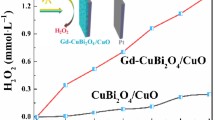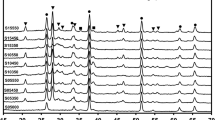Abstract
CuBi2O4 is a promising p-type semiconductor material with a theoretical maximum current density of about 19.7 mA cm‒2. Although CuBi2O4 has a very high theoretical photocurrent, its poor charge transmission efficiency makes its actual photocurrent far less than its theoretical values. Herein, an in situ modification method is adopted to prepare a photocathode material with Ag as conductive channels. A metal–organic coating method is used to introduce Ag conductive channels, promoting the charge transmission between grains. Ag particles play the role of electrical connection, and improve the separation and transmission of carriers, so as to obtain enhanced photocurrent density.
Graphical Abstract
In situ formed Ag conductive channels significantly enhanced the PEC performance of CuBi2O4 photocathodes.






Similar content being viewed by others
References
Huang H, Feng J, Li Z, Zou Z (2022) Organics challenge inorganics for efficient photoelectrochemical water oxidation. Sci Bull 67:226–228
Feng J, Zhao X, Zhang B, Chen Z, Li Z, Huang Y (2022) In situ optical spectroscopic understanding of electrochemical passivation mechanism on sol–gel processed WO3 photoanodes. J Energy Chem 71:20–28
Wang Y, Zhang J, Balogun MS, Tong Y, Huang Y (2022) Oxygen vacancy–based metal oxides photoanodes in photoelectrochemical water splitting. Mater Today Sustain 18:100118
Zhang G, Guan Z, Yang J, Li Q, Zhou Y, Zou Z (2022) Metal sulfides for photocatalytic hydrogen production: current development and future challenges. Sol RRL 6:2200587
Hu Y, Huang H, Feng J, Wang W, Guan H, Li Z, Zou Z (2021) Material design and surface/interface engineering of photoelectrodes for solar water splitting. Sol RRL 5:2100100
Song Y, Zhang X, Zhang Y, Zhai P, Li Z, Jin D, Cao J, Wang C, Zhang B, Gao J, Sun L, Hou J (2022) Engineering MoOx/MXene hole transfer layers for unexpected boosting of photoelectrochemical water oxidation. Angew Chem Int Ed 61:e202200946
Hu Y, Li Q, Hao L, Guan H, Wang Y, Zhang W, Du H, Tian W, Hu Q (2022) Improving photoelectrochemical performance of α-Fe2O3 photoanode by ethylene glycol assisted antimony treatment. Mater Lett 323:132550
Hu Y, Hu Q, Zhong Q, Guan H, Hao L, Wang Y, Zhang W, Du H, Tian W (2022) Improved charge separation and injection efficiencies of bismuth vanadate photoanode by depositing composite CoOx/CuO cocatalyst. ChemistrySelect 7:e202202057
Zhang N, Wang X, Feng J, Huang H, Guo Y, Li Z, Zou Z (2020) Paving the road toward the use of beta-Fe2O3 in solar water splitting: Raman identification, phase transformation and strategies for phase stabilization. Natl Sci Rev 7:1059–1067
Feng J, Zhao X, Zhang B, Yang G, Qian Q, Ma SSK, Chen Z, Li Z, Huang Y (2020) Sol-gel synthesis of highly reproducible WO3 photoanodes for solar water oxidation. Sci China Mater 63:2261–2271
Oropeza FE, Feleki BT, Zhang KHL, Hensen EJM, Hofmann JP (2019) Influence of reduced Cu surface states on the photoelectrochemical properties of CuBi2O4. ACS Appl Energy Mater 2:6866–6874
Reddy DA, Kim Y, Varma P, Gopannagari M, Reddy KAJ, Hong DH, Song I, Kumar DP, Kim TK (2022) Inverse opal CuBi2O4 photocathodes for robust photoelectrochemical water splitting. ACS Appl Energy Mater 5:6050–6058
Gopannagari M, Reddy DA, Hong DH, Reddy KAJ, Kumar DP, Ahn HS, Kim TK (2022) Augmented photoelectrochemical water reduction: influence of copper vacancies and hole-transport layer on CuBi2O4 photocathode. J Mater Chem A 10:6623–6635
Bagal IV, Chodankar NR, Hassan MA, Waseem A, Johar MA, Kim DH, Ryu SW (2019) Cu2O as an emerging photocathode for solar water splitting—a status review. Int J Hydrog Energy 44:21351–21378
Lee MH, Takei K, Zhang J, Kapadia R, Zheng M, Chen YZ, Nah J, Matthews TS, Chueh YL, Ager JW, Javey A (2012) P-Type InP nanopillar photocathodes for efficient solar-driven hydrogen production. Angew Chem Int Ed 51:10760–10764
Jiang T, Zhao Y, Xue H (2019) Boosting the performance of delafossite photocathode through constructing a CuFeO2/CuO heterojunction for photoelectrochemical water reduction. J Mater Sci 54:11951–11958
Yu X, Prévot MS, Guijarro N, Sivula K (2015) Self-assembled 2D WSe2 thin films for photoelectrochemical hydrogen production. Nat Commun 6:7596
Ji L, McDaniel MD, Wang S, Posadas AB, Li X, Huang H, Lee JC, Demkov AA, Bard AJ, Ekerdt JG, Yu ET (2015) A silicon-based photocathode for water reduction with an epitaxial SrTiO3 protection layer and a nanostructured catalyst. Nat Nanotechnol 10:84–90
Song A, Bogdanoff P, Esau A, Ahmet IY, Levine I, Dittrich T, Unold T, Van de Krol R, Berglund SP (2020) Assessment of a W:BiVO4-CuBi2O4 tandem photoelectrochemical cell for overall solar water splitting. ACS Appl Mater Interfaces 12:13959–13970
Ramezanalizadeh H, Rafiee E (2020) Design, fabrication, electro- and photoelectrochemical investigations of novel CoTiO3/CuBi2O4 heterojunction semiconductor: an efficient photocatalyst for the degradation of DR16 dye. Mater Sci Semicon Proc 113:105055
Pulipaka S, Boni N, Ummethala G, Meduri P (2020) CuO/CuBi2O4 heterojunction photocathode: high stability and current densities for solar water splitting. J Catal 387:17–27
Monny SA, Zhang L, Wang Z, Luo B, Konarova M, Du A, Wang L (2020) Fabricating highly efficient heterostructured CuBi2O4 photocathodes for unbiased water splitting. J Mater Chem A 8:2498–2504
Shah AK, Sahu TK, Banik A, Gogoi D, Peela NR, Qureshi M (2019) Reduced graphene oxide modified CuBi2O4 as an efficient and noble metal free photocathode for superior photoelectrochemical hydrogen production. Sustain Energy Fuels 3:1554–1561
Xu Y, Jian J, Li F, Liu W, Jia L, Wang H (2019) Porous CuBi2O4 photocathodes with rationally engineered morphology and composition towards high-efficiency photoelectrochemical performance. J Mater Chem A 7:21997–22004
Li C, He J, Xiao Y, Li Y, Delaunay JJ (2020) Earth-abundant Cu-based metal oxide photocathodes for photoelectrochemical water splitting. Energy Environ Sci 13:3269–3306
Xu N, Li F, Gao L, Hu H, Hu Y, Long X, Ma J, Jin J (2018) N, Cu-codoped carbon nanosheet/Au/CuBi2O4 photocathodes for efficient photoelectrochemical water splitting. ACS Sustain Chem Eng 6:7257–7264
Wei S, Wang C, Long X, Wang T, Wang P, Zhang M, Li S, Ma J, Jin J, Wu L (2020) A oxygen vacancy-modulated homojunction structural CuBi2O4 photocathodes for efficient solar water reduction. Nanoscale 12:15193–15200
Zhang Q, Zhai B, Lin Z, Zhao X, Diao P (2021) CuO/CuBi2O4 bilayered heterojunction as an efficient photocathode for photoelectrochemical hydrogen evolution reaction. Int J Hydrog Energy 46:11607–11620
Acknowledgements
This work is supported by National Natural Science Foundation of China (Nos. 22109059, 22206065), Natural Science Foundation of the Jiangsu Higher Education Institutions of China (No. 20KJB430025), Natural Science Foundation of Jiangsu Province (No. BK20221167), Jiangsu Innovation and Entrepreneurship Training Program for College Students (No. 202213573037Z), the Foundations Support from Jinling Institute of Technology (Nos. JIT-B-201833, JIT-FHXM-201920, JIT-B-201903).
Author information
Authors and Affiliations
Contributions
YH: Investigation, Data curation, Methodology, Formal analysis, Writing—original draft. XM: Data curation, Writing—review & editing. YQ: Data curation, Methodology, Formal analysis. WZ: Resources, Formal analysis. CL: Resources, Formal analysis. YW: Methodology, Formal analysis, Writing—original draft. HG: Resources, Formal analysis, Writing—review & editing. LH: Supervision, Formal analysis.
Corresponding authors
Ethics declarations
Conflict of interest
The authors declare no competing financial interest.
Additional information
Publisher's Note
Springer Nature remains neutral with regard to jurisdictional claims in published maps and institutional affiliations.
Supplementary Information
Below is the link to the electronic supplementary material.
Rights and permissions
Springer Nature or its licensor (e.g. a society or other partner) holds exclusive rights to this article under a publishing agreement with the author(s) or other rightsholder(s); author self-archiving of the accepted manuscript version of this article is solely governed by the terms of such publishing agreement and applicable law.
About this article
Cite this article
Hu, Y., Min, X., Qi, Y. et al. Enhanced Photoelectrochemical Hydrogen Evolution on CuBi2O4 Photocathode with Silver as Conductive Channels. Catal Lett 154, 34–41 (2024). https://doi.org/10.1007/s10562-023-04292-4
Received:
Accepted:
Published:
Issue Date:
DOI: https://doi.org/10.1007/s10562-023-04292-4




